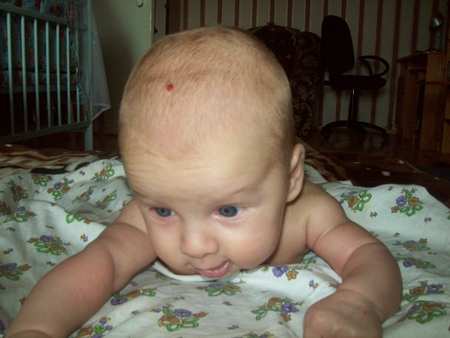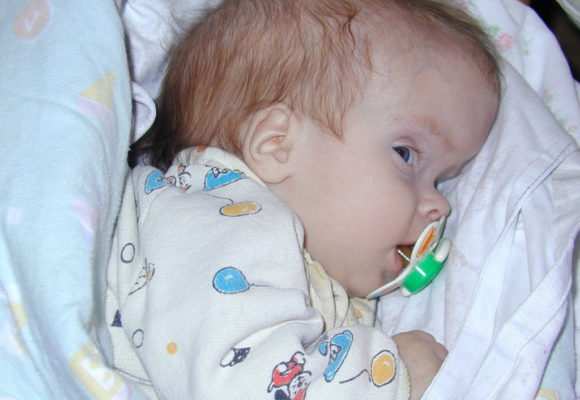Antipyretics for children are prescribed by a pediatrician. But there are emergency situations with fever when the child needs to be given medicine immediately. Then the parents take responsibility and use antipyretic drugs. What is allowed to be given to infants? How can you lower the temperature in older children? What medications are the safest?
Many young mothers are very worried if they notice that their newborn’s head is uneven. Lack of experience gives rise to fear and uncertainty: what if something is wrong with the child? However, experts are in a hurry to reassure. In most cases, an uneven head in a baby is normal. There are only a few cases where an uneven head reports problems. For example, a child may have a hematoma.
Not only the mother’s body prepares for childbirth. The child also internally prepares for such a process. The baby's skull remains soft until birth. This makes it easier for the mother to pass through the narrow birth canal. This was how nature intended. This is why babies whose mothers give birth themselves have a slightly uneven or large head.
The reason is a slight deformation of the skull: at birth, the flat head stretches out and takes on an uneven, elongated shape. There is no pathology in this, so you can calm down. There are no special rules provided here.
At birth, a baby’s skull is always slightly deformed: even if it wasn’t like that right away, changes may appear later. However, after some time, the skull will acquire a normal shape, the asymmetry will be restored, and changes in circumference will no longer be noticeable. Therefore, there is no need to worry too much about this.
The head does not take its final shape immediately. For some, the features of the head circumference are formed only by school age.
Usually the skull becomes round and even by one year or a little later.
Changes
However, sometimes a flat head takes on a completely unnatural shape. Sometimes the reason for this is a hematoma, but the position of the child also matters. For example, a child has a very sloping head. This happens not at birth, but after childbirth: the head becomes flattened, uneven, large, and sometimes its girth does not correspond to the norm.
If the back of the baby's head is very elongated or slanted, the cause is most often the incorrect position of the child. He can remain in a lying position for a long time, which leads to such changes. Usually in such cases, children turn and tilt their head to one side.

It is dangerous to constantly place your baby on his back. This position is not always harmless, since the baby can spit up and choke, sometimes even choke. What to do? It is recommended to place babies on their side, but change sides. This will help avoid changes and deformations of the skull.
Children always turn their heads towards something interesting: there may be a mother or a rattle. If the crib is located against a wall, the baby will only have to turn in one direction. This can also cause disturbances and deformation of the skull. A sloping nape may also appear.
The bones of the skull remain soft in the first months of life: this protects it from injury and helps brain development.
Special areas - fontanelles - are soft tissue, the cells of which are very elastic. While the fontanelles are open, the shape of the head may change. For example, it may become flat, or the back of the head may become skewed to one side. This means that the child has been lying on his back for a long time.
Violations
Many young mothers worry when they notice irregularities and irregularities in the circumference of the baby’s head. But pediatricians and doctors reassure: as soon as the child stops lying down and starts sitting up, the situation will change. This usually happens when the baby spends more time in an upright position. Already at 2-3 months the skull begins to straighten, changes in circumference disappear.
However, sometimes deformation of the circle is a sign that the asymmetry is broken. This happens for various reasons: the baby lacks vitamins, diseases appear and begin to manifest themselves. For example, rickets, which is common in children, often manifests itself this way.

If a baby has rickets, his bones do not strengthen due to lack of calcium, develop poorly, and grow poorly. The fontanelles do not overgrow, so the baby’s head remains soft for a long time, and the skull is subject to changes. Usually in such situations, doctors advise being with the baby in the fresh air more often, and also giving him vitamin D and calcium.
If the baby begins to turn his head only in one direction, his neck may be crooked. It doesn’t matter whether the child is lying down or in his arms. In this case, you should definitely contact a specialist.
A doctor’s consultation will also be required in another case: if the fontanelles quickly overgrow. Intracranial pressure may occur, leading to serious problems.
What to do in this case? An experienced doctor will immediately identify violations of the circumference and girth of the head. But it is better to carry out routine examinations with a neurologist and surgeon. This will allow you to identify problems at the first stage.
A hematoma deserves special attention. It is an accumulation of blood or fluid in areas where soft tissue cells rupture. It usually happens right under the skin or near the skull. Why does a hematoma occur? If the child was large and walked heavily, he had to “pave” his way. This causes damage such as a hematoma.
A hematoma can also appear in another case: if the mother had a cesarean section. The baby moves from one environment to another, and this happens abruptly. Tissue cells cannot immediately adapt to the new environment, which is why a hematoma forms. For a child, this phenomenon is stress. If the hematoma becomes larger than normal, this is a bad sign.

Hematoma often appears in premature babies. Sometimes it is the cause of curvature of the circumference and incorrect girth of the skull. The hematoma may resolve on its own, but medical intervention may be required. In any case, you must first conduct a diagnosis and identify the type of hematoma, especially if it is large. This is out of the norm.
How to align the head
A sloping and irregular back of the head, a flat head, a convex forehead, irregular asymmetry - all these situations are not always a cause for concern. But only a doctor can determine the cause. If the case is dangerous, they may prescribe an additional examination and collect tests. In any case, you should first consult a doctor to eliminate your own fears.
There are some things parents can do themselves:
- a beautiful, even skull can be formed by alternating sides of the bed. For example, first the headboard is on one side, then on the other. The breast and container of milk should also be served to the baby from different sides. You can lay your child in different directions each time, change position. The standards will be respected;
- It is necessary to hold the child in your arms more often. For the same reason, it is recommended to turn the baby onto his tummy more often. In this position, its head will not be able to bend, asymmetry will be eliminated, and the back of the head will take on the desired shape.
The recommendations presented above are sufficient if the situation is not critical. But some mothers believe that their baby’s head is crooked and try to correct it in every possible way. Don't try everything: the most effective method is massage. But the delicate skin and soft bones of a newborn should be treated with extreme caution. This is not a massage. You just need to carefully give the skull and head the desired shape.
You can contact an orthopedist and consult with him about using an orthopedic pillow: sometimes such a thing is very useful, this is confirmed by numerous reviews.



